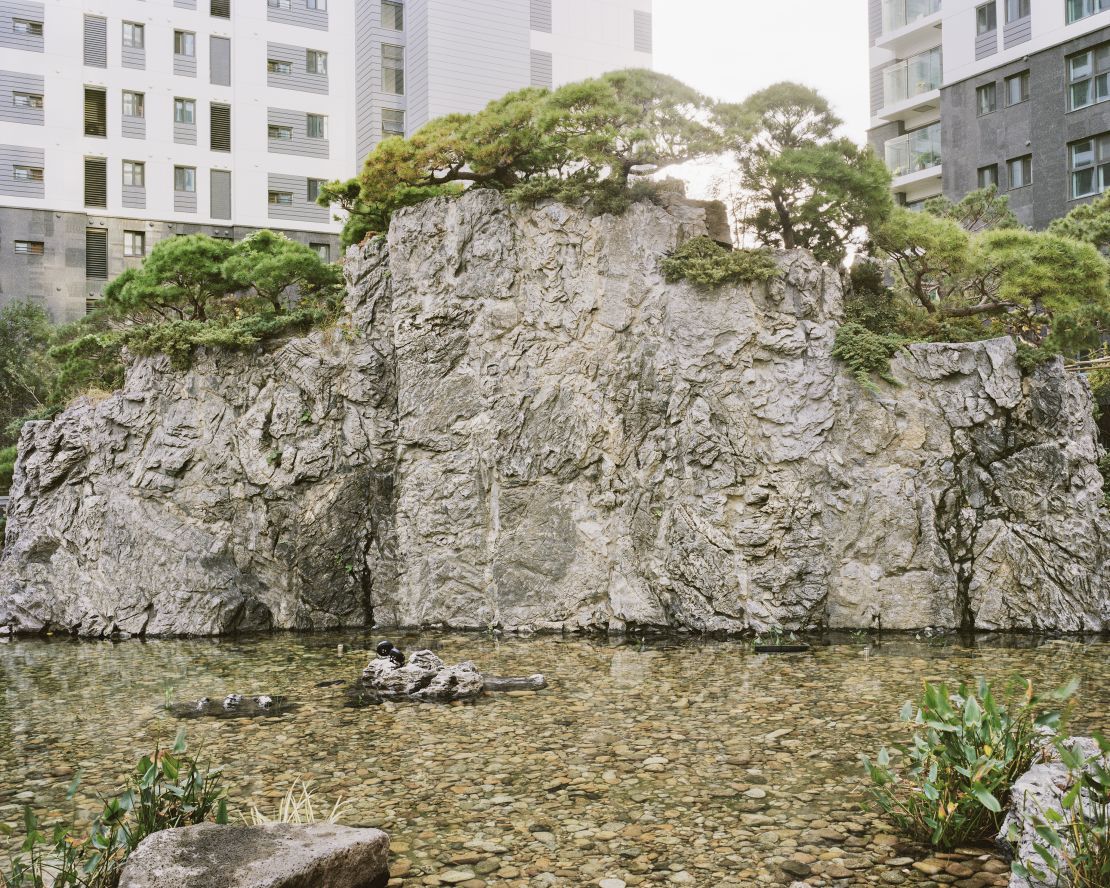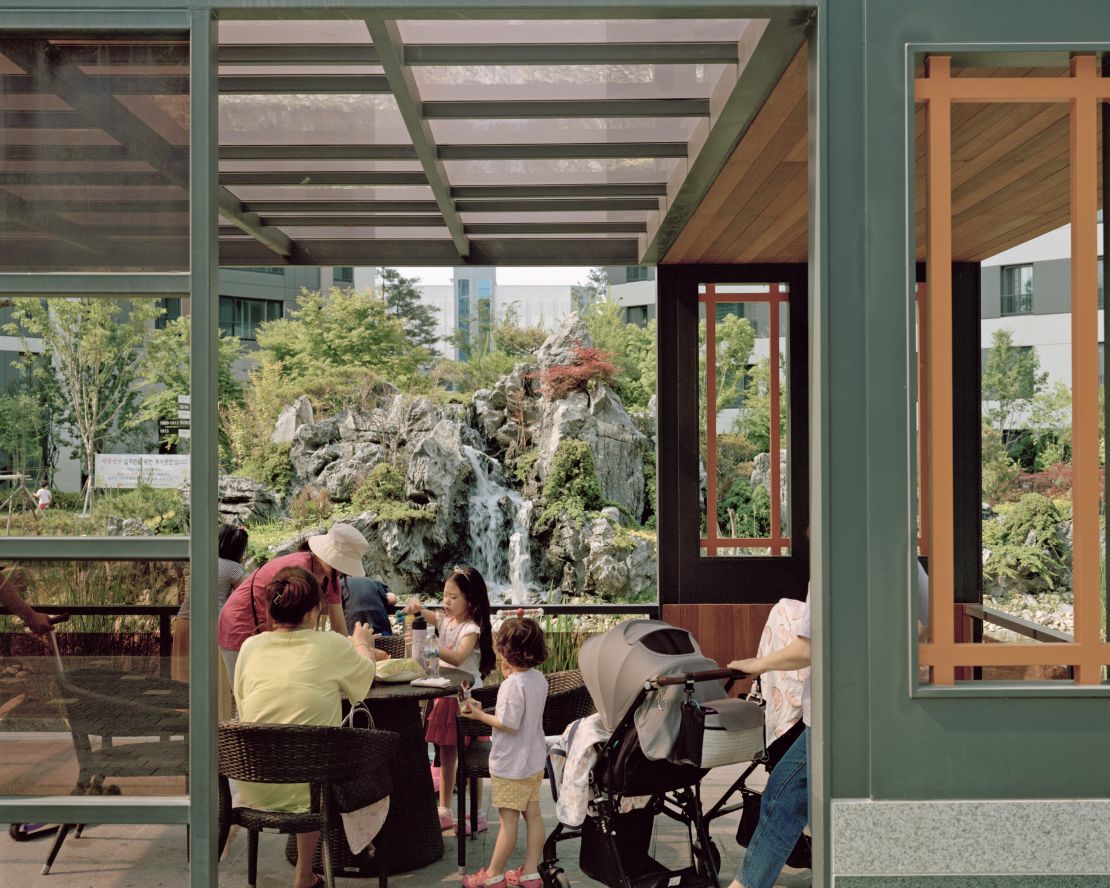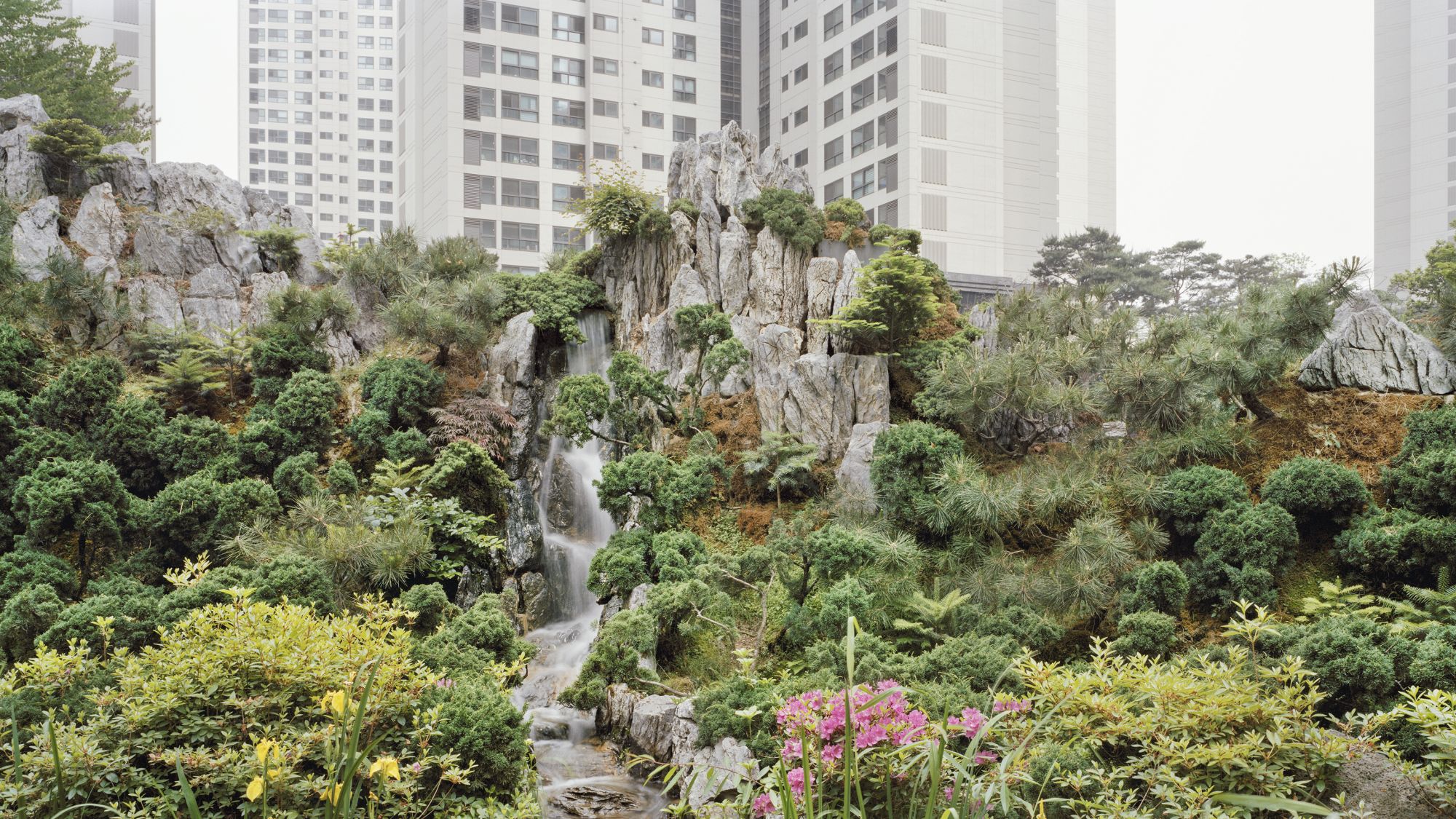Plush green pine trees are densely planted on rocky hills outside a towering apartment block in Seoul. They resemble South Korea’s famed Dodamsambong Peaks, but are just a fraction of the size.
This beautification trend, known as “jingyeong sansu,” seeks to recreate the country’s most famous mountains – on a much smaller scale – outside luxury apartment complexes and private villas.
The artificial mountains are built by real estate developers hoping to improve the buildings’ feng shui – and market value. Some residents also believe that they bring the healing power of nature to their front doors.
Seoul-based photographer Seunggu Kim has been capturing these unconventional structures since 2011. In that time, he has visited around 30 apartment complexes fitted with grandiose rock gardens and tree-covered hills.

Having spent his 20s working on construction sites, Kim was often among the first people to witness the months-long process of reproducing the country’s best known mountains.
Workers first build a basic Styrofoam mold, which is secured on or around the apartment block, he said. Then they cover it with soil, before planting flowers and trees.
The structures are often accompanied by engravings describing the positive energy each mountain is thought to bring, from fertility and aspiration to peace of mind.
Photographer captures Seoul's 'fake mountains'
“I realized this is not just an artificial landscape but a new environment that combines tradition and philosophy,” Kim said in a phone interview. “It is interesting to see how capitalistic it has become.”
The mountains’ extravagant price tag – up to $2 million for a design up to 20 meters tall – mean they are typically found in luxury apartment complexes. Only high-quality materials are used, including expensive rocks and bonsai, and each mountain is maintained by a team of experts.
Uniquely Korean
Mountains cover around 70% of the Korean peninsula and are an integral part of Korean identity. The mythical story of Korea’s foundation begins in the Taebaek mountain range.
According to Korean legend, Hwan-ung descended from heaven and was approached by a bear that wanted to be a woman. Hwan-ung told the bear to eat garlic and herbs for 100 days in a cave. It worked, and the bear-woman later married Hwan-ung and gave birth to Dangun, who founded the kingdom in 2333 BC.
While many consider the legend to be a myth, North Korean archaeologists claimed to have found Dangun’s grave at the foot of Taebaek mountain near the North Korean capital, Pyongyang, and built a mausoleum at the site in 1994 to venerate him.
Today, mountains on both sides of the border between North and South Korea are believed to bring luck and fortune. Both countries celebrate the foundation of Korea – the day the heavens opened to Hwan-ung – on October 3 every year.
“There’s a positive and shamanistic belief towards mountains in Korea, so it’s like compressing it and bringing it back into a city where there is lack of nature,” said Kim. “My work is to discover Korean landscapes that still exist in modern society.”

Some of the more popular designs are Mount Seorak, in the Taebaek mountain range of Gangwon province, and Jeju Island’s Halla, the country’s highest mountain.
Mount Kumgang in North Korea is also popular, as South Korean tourists have been unable to visit the real thing since 2008, due to political tensions.
Back to nature
The popularity of artificial landscapes suggests that residents are trying to strengthen their bond with nature after decades of rapid urbanization. It’s this attempt to reconnect that Kim seeks to capture in his photos, according to curator Haeni Park.
“Through his work, Kim reveals his understanding of the reality of our society, where people living in cities that can be rather bleak actually take solace, if only for a moment, from the colorful artificial structures,” she wrote in her curatorial statement for Kim’s 2015 exhibition “A List of Landscapes.”

For Kim, this simulacrum of nature comes as mo surprise, given the country’s topographic limitations.
“South Korea has developed a compressed throwaway culture, as we have relatively good amount of resources but not enough time and space to spend (them),” said Kim. “(The fake mountains) represent an alternative landscape that city-dwellers had to accept.”
Finding joy
Kim has photographed the same structures over many years in order to observe seasonal changes in their shape and color. He initially saw “kitsch” landscape design as one of the symptoms of rapid economic growth in South Korea. But he has since grown to appreciate the mountains’ beauty and the “healing” effect they have, he said.
“Sometimes when I am out there photographing fake hills, old residents come up to me and explain the significance of the mountain with so much pride, as if they are real and they own it,” the photographer recalled. “I found that sense of ownership very unique.”
Kim said that, today, people have had to find alternative ways to enjoy nature and relax. He calls it “instant culture,” and it’s the wider theme of his lifelong attempt to capture how South Korean urbanites deal with their “relentless desire to find joy in the toughest times.”
His other ongoing series on life in South Korea’s cities features images of citizens attempting to cling onto their leisure spaces – regardless of what else is going on – such as a man walking his dog next to a flooded park and a jam-packed swimming pool in the middle of Seoul.

Kim sees himself as an observer or recorder, rather than an artist. He hopes his photos offer a realistic depiction of South Korea’s capitalistic society.
“I want to reveal the identity of modern Korea – an ironic, optimistic and joyful Korean society, and its twisted consumer culture.”
















